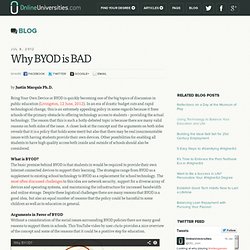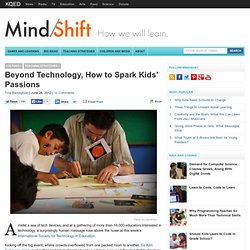

11 Reasons Teachers Aren't Using Technology #edchat #edtech. 10 Reasons Students Aren’t Actually Using eTextbooks. Why BYOD is BAD. Bring Your Own Device or BYOD is quickly becoming one of the big topics of discussion in public education (Livingston, 12 June, 2012).

In an era of drastic budget cuts and rapid technological change, this is an extremely appealing policy in some regards because it frees schools of the primary obstacle to offering technology access to students – providing the actual technology. The reason that this is such a hotly-debated topic is because there are many valid reasons on both sides of the issue. A closer look at the concept and the arguments on both sides reveals that it is a policy that holds some merit but also that there may be real insurmountable issues with having students provide their own devices. Other possibilities for enabling all students to have high quality access both inside and outside of schools should also be considered. What is BYOD? Some other reasons that BYOD is gaining popularity include: Will BYOD be a Reality in K-12? Snapshot of a modern learner.
The myth and the reality. Beyond Technology, How to Spark Kids’ Passions. Culture Teaching Strategies Flickr:ScratchPost Amidst a sea of tech devices, and at a gathering of more than 18,000 educators interested in technology, a surprisingly human message rose above the noise at this week’s International Society for Technology in Education.

Kicking off the big event, where crowds overflowed from one packed room to another, Sir Ken Robinson, renowned author and international education adviser, proposed the idea that technology is not the only driver for learning. “The problem now is resisting the notion that technology is the answer to everything — it’s clearly not,” Robinson said. “But what part of the equation does technology best speak to?” Robinson, who’s been outspoken about the need to change the education paradigm, emphasized that educators shouldn’t be pushing (or be pushed toward) the gratuitous use of technology.
“We should get rid of the words ‘curriculum delivery.’ “Helping students find their passion will lead them to achievement,” he said. LISTEN. 5 Reasons Why BYOD is a Bad Idea. Ed Note – I think some readers are interpreting this article as somehow being against putting devices in students hands, but I am quite in favor of doing that, with standardized technology.

I know from experience that providing standardized devices eliminates or reduces many of the issues I cite below. When the devices and configurations vary widely and are not under the control of the school, these types of problems can make use of these devices fraught with disruptive issues. User feedback is leading me to rethink this a little, but I am not hearing a lot that is effectively addressing these specific issues just yet. – KW When I first read about the idea of BYOD programs in schools, my initial reaction was that it is certainly one way to get technology in the hands of all students in a school or class without having to find lots of budgetary funds to do it.
Here are a number of problems with the BYOD initiative for schools: What do you think? 7 Ways To Keep Students Focused While Using Technology. When used effectively, technology plays an important role in enhancing the learning process. Teachers can use digital devices to present supplemental material for lessons or to encourage students to take a more hands-on role in their education. Even with all of the benefits of technology in the classroom, however, educators must use caution to ensure that students are focusing on the lesson and not giving in to distractions.
Here are seven ways that teachers can use to help students pay more attention when using technology: 1. Encourage direct engagement. One of the benefits of technology is that students can interact with and learn from lesson materials directly rather than waiting for a passive transfer of information. 2. Technology has made in-class participation easier than ever. 3. Students learn better when they are more engaged with the material and are encouraged to make it their own. 4. 5. 6. 7. Wat belemmert het gebruik van ICT in het onderwijs. MindShift vat op basis van de K12-editie van het Horizon-rapport samen welke factoren op dit moment belemmerend werken voor de adoptie van ICT in het (Amerikaanse) onderwijs.

Ik mis drie cruciale factoren. Er is bij professionalisering van docenten weinig aandacht voor digitale geletterdheid (digital media literacy), ondanks dat deze bekwaamheid van essentieel belang is geworden. Daarbij gaat het overigens nietabout tools and more about thinking, and thus skills and standards based on tools and platforms have proven to be somewhat ephemeral.Binnen het onderwijs zal er meer aandacht besteed moeten worden aan een mix van formeel en informeel leren. Binnen de lessen zullen informele leeractiviteiten meer een plek moeten krijgen, en leren buiten school zal binnen curricula meer geïntegreerd moeten worden. Het concept van de flipped classroom biedt hier mogelijkheden voor, schrijft MindShift. De vijfde en zesde reden hangen uiteraard nauw met elkaar samen.